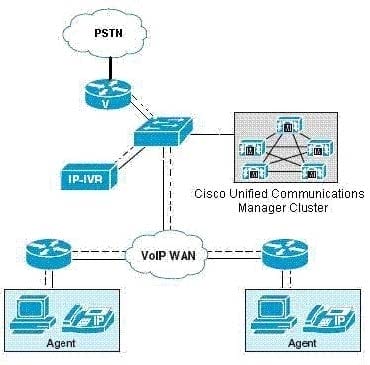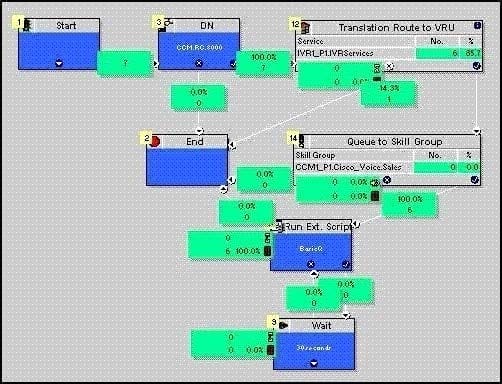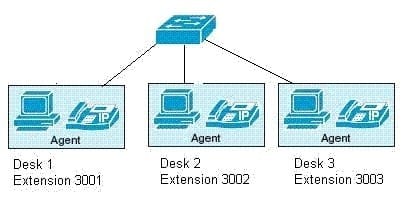Exam Details
Exam Code
:642-243Exam Name
:Unified Contact Center Enterprise SupportCertification
:Cisco CertificationsVendor
:CiscoTotal Questions
:44 Q&AsLast Updated
:Mar 25, 2025
Cisco Cisco Certifications 642-243 Questions & Answers
-
Question 11:
Refer to the exhibit. After reviewing the CTIOS log shown in the exhibit, identify the "final" agent state for these agent IDs.
10771 99960

A. Agent 10771 is TalkingAgent 99960 is BusyAgent 99920 is Talking
B. Agent 10771 is AvailableAgent 99960 is TalkingAgent 99920 is Reserved
C. Agent 10771 is ReservedAgent 99960 is AvailableAgent 99920 is Talking
D. Agent 10771 is BusyAgent 99960 is ReservedAgent 99920 is Talking
E. Agent 10771 is ReservedAgent 99960 is ReservedAgent 99920 is Busy
-
Question 12:
In the Cisco Unified Contact Center Enterprise system, which of these steps will enable JTAPI tracing for the Cisco Unified IP IVR/CRS Server?
A. IP-IVR JTAPI traces are enabled during installation by default with IP-IVR/CRS 4.X and higher.
B. Enable debugging from the IP-IVR/CRS Application Administration System > Tracing > CRS Engine > Subsystems > SS_Tel and SS_ICM.
C. In the IP-IVR/CRS Server - Start Programs > CiscoJTAPI > Cisco Unified Communications JTAPI Preference.
D. JTAPI tracing is handled by the Cisco Unified Communications Manager so JTAPI tracing is enabled by activating the CTI Manager tracing.
-
Question 13:
Refer to the exhibit. In a Cisco Unified Contact Center Enterprise deployment, calls are failing during the Translation Route to the Cisco Unified IP IVR. Review the MIVR log file and select the most possible reason for this failure.

A. There are not enough Sessions configured on the JTAPI Trigger configuration of the Cisco Unified IP IVR.
B. There are not enough Channels configured in the Cisco Media Group of the Cisco Unified IP IVR.
C. There are not enough CTI Ports configured in the CTI Port Group of the Cisco Unified IP IVR.
D. The CTI Port's Partition is not in the Calling Search Space of the JTAPI Trigger in the Cisco Unified IP IVR.
-
Question 14:
Refer to the exhibit. An agent in a Cisco Unified Contact Center Enterprise system is reporting that the system is automatically changing the agent's state from "Ready" to "Not-Ready" for no apparent reason.
In the Cisco Unified Communications Manager configuration, the default Calling Search Space for the CTI Ports and CTI Route Points is "Calling Party."
Given the log file and Cisco Unified Communications Manager configuration, which option is the most likely cause of the failure?

A. The agent walked away from the desk without putting him or herself into "Not Ready."To resolve this issue instruct the agent to put his or her phone in a "Not Ready" state before leaving the workstation.
B. The error is caused by a Cisco Unified Communications Manager Calling Search Space mis- configuration.The Calling Search Space of the CTI Route Point 1208 needs to have the agent's extension 613373 in Cisco Unified Communications Manager.
C. The error is caused by a Cisco Unified Communications Manager Calling Search Space mis- configuration.The Calling Search Space of the calling device needs to have the agent's extension 613373 in Cisco Unified Communications Manager.
D. The agent's extension 613373 is not associated with the IP-IVR JTAPI/CTI user in Cisco Unified Communications Manager.From the Cisco Unified Communications Manger Administration > User; add extension 613373 as a controlled device.
-
Question 15:
When troubleshooting calls that are dropping in the Cisco IP IVR in the Cisco Unified Contact Center Enterprise solution, which log file settings would be useful? Select the three best options for tracing from the AppAdmin > System > Tracing menu. (Choose three.)
A. Trace Configuration > CRS Engine > SUBSYSTEMS turn on these MIVR trace Debug levels SS_TEL and SS_ICM
B. Trace Configuration > CRS Engine > SUBSYSTEMS turn on these MIVR trace Debug levels SS_TEL and SS_JTAPI and SS_ICM
C. Trace Configuration > CRS Engine > SUBSYSTEMS Under MISCELLANEOUS, turn on this MIVR trace Debug level for ENG
D. Trace Configuration > CRS Engine > SUBSYSTEMS Under LIBRARIES, turn on this MIVR trace Debug level for LIB_ICM
E. Trace Configuration > CRS Engine > SUBSYSTEMS Under LIBRARIES, turn on this MIVR trace Debug level for LIB_JTAPI
-
Question 16:
Refer to the exhibit. In a Cisco Unified Contact Center Enterprise deployment using the Multi-Site Centralized call processing model, all calls come into the central site for treatment or queuing and are then transferred across the WAN to agents. In this deployment, agents have reported that they are getting stuck in a reserved state but not getting the actual call delivered to them. What is the most likely cause of this failure?

A. There are not enough Cisco Unified IP IVR ports available to queue calls at the central site.
B. The agents have lost connection to the centralized CTI OS Servers.
C. The agent's phone was off-hook during the transfer from the Cisco Unified IP IVR.
D. There was not enough bandwidth for the call over the WAN, and the Cisco Unified Communications Manager's Locations-based Call Admission Control rejected the call setup.
-
Question 17:
In a Cisco Unified Contact Center Enterprise deployment, callers are reporting that when they call in, their calls are being intermittently dropped without hearing a welcome or queue message.
Which two problems could potentially cause calls not to reach the Cisco Unified IP IVR? (Choose two.)
A. The Cisco Unified IP IVR Media Group does not have any remaining channels.
B. The number of ports in the Cisco Unified IP IVR Call Control Group does not match the number of ports in the Cisco Unified IP IVR Media Control Group.
C. There are more Cisco Media Channels configured in the Cisco Unified IP IVR than Cisco Unified Communications Manager CTI Ports assigned in the Cisco Unified IP IVR.
D. The Cisco Unified Communications Manager Calling Search Space of the Gateway of the call does not have access to the partition in which the Cisco Unified IP IVR CTI Ports are found.
E. The CTI Ports have not been assigned to a Call Control Group via AppAdmin in Cisco Unified IP IVR.
F. The Cisco Unified IP IVR CTI Ports do not have a Calling Search Space assigned in Cisco Unified Communications Manager.
-
Question 18:
Refer to the exhibit. In a Cisco Unified Contact Center Enterprise system, callers have reported that their calls are dropping intermittently without hearing any greetings or queue music. At times they are able to hear Cisco Unified IP IVR
prompts but are then dropped before connecting to an agent.
The Cisco Unified Communications Manager is configured as follows for this deployment:
All CTI Route Points that make requests to Cisco Unified ICM have names that start with "IPCC."
All CTI Route Points used for Cisco Unified ICM Translation Routing to the Cisco Unified IP IVR are named starting with "Trans."
All CTI Ports used by the Cisco Unified IP IVR are named starting with "CTI."
All Agent Phones are named starting with "SEP."
There is concern about how these devices are associated in the Cisco Unified Communications Manager configuration. The device associations for the PGuser and IVRuser are shown in the exhibit.
Given the problem and the current device associations, what two things might be causing these call failures? (Choose two.)

A. "Enable CTI Application Use" is not checked on the PGuser and IVRuser configurationoptions
B. The Peripheral Gateway and Cisco Unified IP IVR do not use the PGuser nor IVRuser Cisco Unified Communications Manager user accounts
C. CTI_1300 and TransRtPT3 should not be associated with the PGuser Cisco Unified Communications Manager user account
D. All devices should be associated with both the PGuser and IVRuser Cisco Unified Communications Manager user accounts
E. The Agent IP Phone 3001 should not be associated with the IVRuser Cisco Unified Communications Manager user account
F. The problem is not with the configuration. The Cisco Unified Communications Manager database subscription is broken on subscribers
-
Question 19:
Refer to the exhibit. In a Cisco Unified Contact Center Enterprise deployment, the Cisco Unified ICM Call Routing Script shows one call failed in the Translation Route to VRU node. How will the system treat this call?

A. If a Default Route is configured on the Peripheral, the call is redirected to the number configured under "Forward On Failure" on the CTI Route Point used for the Dialed Number in Cisco Unified Communications Manager.
B. The caller would hear the default error prompt from the Cisco Unified IP IVR.
C. The script would return the label 8000, so the call is redirected to the extension 8000 in Cisco Unified Communications Manager.
D. If a Default Route is configured on the Peripheral, the call is rerouted to the Default Route.
-
Question 20:
Refer to the exhibit. In a Cisco Unified Contact Center Enterprise deployment with agents deployed as shown in the exhibit, an agent has reported receiving CTI screen pops for calls, but then the call is not sent to the agent. What is a possible cause of this problem?

A. The agent logged in with an extension that does not exist.
B. The agent logged in using an extension that is assigned to another agent's phone.
C. The agent's phone is not associated with the PG User.
D. The agent is still logged into CTIOS on another PC.
Related Exams:
300-915
Developing Solutions using Cisco IoT and Edge Platforms (DEVIOT)300-920
Developing Applications for Cisco Webex and Webex Devices (DEVWBX)352-011
Cisco Certified Design Expert Practical500-052
Cisco Unified Contact Center Express500-173
Designing the FlexPod Solution (FPDESIGN)500-174
Implementing and Administering the FlexPod Solution (FPIMPADM)500-201
Deploying Cisco Service Provider Mobile Backhaul Solutions500-210
SP Optical Technology Field Engineer Representative500-220
Cisco Meraki Solutions Specialist500-230
Cisco Service Provider Routing Field Engineer
Tips on How to Prepare for the Exams
Nowadays, the certification exams become more and more important and required by more and more enterprises when applying for a job. But how to prepare for the exam effectively? How to prepare for the exam in a short time with less efforts? How to get a ideal result and how to find the most reliable resources? Here on Vcedump.com, you will find all the answers. Vcedump.com provide not only Cisco exam questions, answers and explanations but also complete assistance on your exam preparation and certification application. If you are confused on your 642-243 exam preparations and Cisco certification application, do not hesitate to visit our Vcedump.com to find your solutions here.